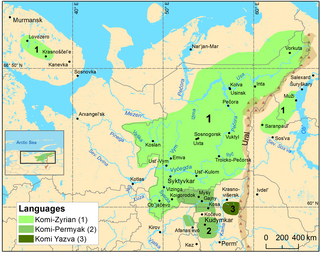|
Komi-Yazva language
The Komi-Yazva language (коми-ёдз көл, komi-jodz kål) is a Permic language closely related to Komi-Zyrian and Permyak, and spoken mostly in Krasnovishersky District of Perm Krai in Russia, in the basin of the Yazva (Yodz) River. It has no official status. It is the most divergent of all the Komi varieties.[2] About two thousand speakers densely live in Krasnovishersky District.  StudiesAvailability[clarification needed] of the particular vowels together with features of phonetics and stress system led Finnish linguist Arvid Genetz in 1889 to consider Komi-Yazva as a separate dialect.[citation needed] Later, this decision was confirmed by the famous Finno-Ugricist Vasily Lytkin, who studied the Komi-Yazva idiom in depth from 1949 until 1953.[citation needed] LinguogeographyArea and numberIn the early 1960s, about 2,000 speakers lived compactly on the territory of Krasnovishersky District of Perm Krai (Antipinskaya, Parshakovskaya, Bychinskaya and Verkh-Yazvinskaya village administrations). In total, there were about 3,000 language-speakers.[3] StatusThe presence of special vowel sounds, specific phonetics and accent system allowed first Finnish linguist Arvid Genetz, who studied the people in 1889, and then the Finno-Ugric philologist Vasily Lytkin, who visited the Komi-Yazvinians three times between 1949 and 1953, to identify the Komi-Yazvinians as a separate dialect.[3] Some researchers consider it to be a dialect of the Komi-Permyak language.[4] AlphabetThe first Komi-Yazva primer was printed in 2003. Its author was the teacher of the Parshavskaya school A. L. Parshakova. This book also became the first one ever printed in Komi-Yazva language.
See alsoReferences
Bibliography
|
||||||||||||||||||||||||||||||||||||||||||||||||||||||||||||||||||||


